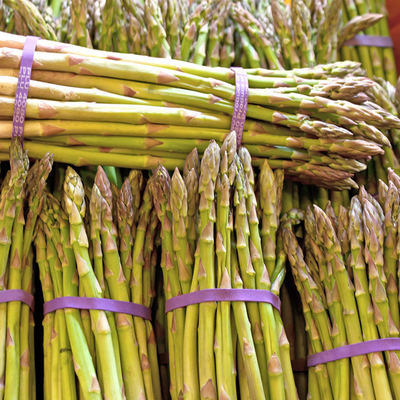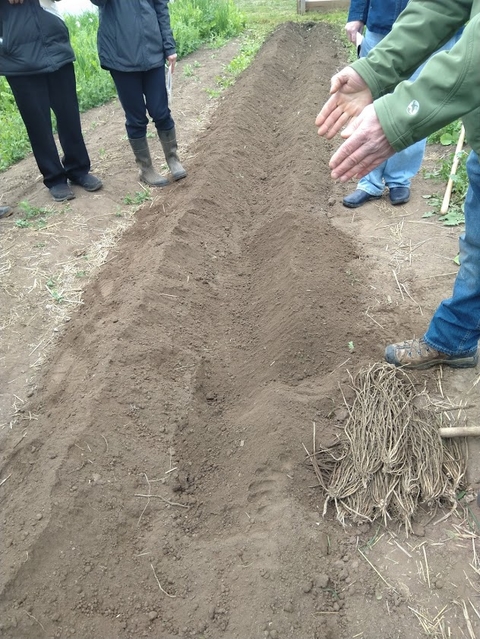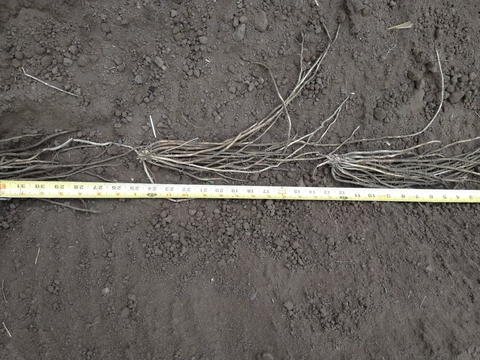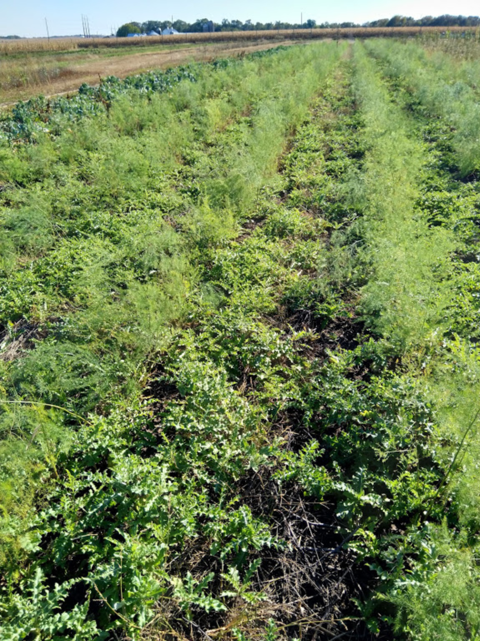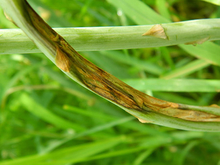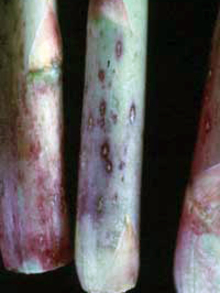A quick guide to asparagus
- An asparagus plant can last 15 years. Choose its spot in the garden carefully.
- You can start asparagus from seed or from one-year-old roots, called crowns.
- Crowns grow vertically and horizontally. Planting at the right depth is important.
- Good soil moisture is important at planting for good root and fern growth.
- Begin harvest two years after planting crowns, and three years after planting seeds.
- Harvest spears until June 30, then allow the large feathery ferns to develop.
Asparagus is a sign of spring
Asparagus (Asparagus officinalis) is one of the earliest harvested vegetables each spring. Asparagus spears are crisp, tender and flavorful. The asparagus harvest season lasts about 6 to 8 weeks, from early May to late June in Minnesota. In the peak of asparagus season, asparagus spears can grow up to 2 inches per day, producing bountiful harvests for gardeners to enjoy.
How asparagus grows
Asparagus is a unique crop. It is one of the few perennial vegetables grown in Minnesota; others include horseradish and rhubarb.
The edible parts of the plant are called the spears. These are technically the stems of the plants. The spears emerge from underground buds at the base of the root system. These buds and roots are called “crowns.” If spears are left to grow, they develop leaves and are called ferns. Asparagus harvest is only two months instead of the entire season because the plants need time for the ferns to grow and build up energy for the next year.
The fern creates energy that will be stored in the underground portion of the plant to produce the following year’s spears. It is important to take care of the ferns even after the harvest is over to make sure you will have good future harvests.
Soil pH and fertility for asparagus
Asparagus grows best in well-drained soils with a pH between 6.5 to 7.0 and does not tolerate extremely acidic soils. It can grow in heavy, medium, or sandy soils, as long as the soils must be well-drained and do not exhibit pooling water after rains.
Before planting asparagus, have your soil tested to see if the soil has the right amount of nutrients for asparagus to thrive. Add recommended fertilizer based on the soil test results. It is best to add part of the fertilizer in the fall or spring before planting, but about half of the phosphorus and potassium should be added at the time of planting. Nitrogen should be added after planting, once the crowns begin growing.
If you don't have a soil test report, the typical garden fertilizer rate for asparagus is to apply 1 to 1.5 pounds of 10% nitrogen, 10% phosphorus, and 10% potassium fertilizer (10-10-10) per 100 square feet before planting.
Once an asparagus patch is established, it is best to test the soil every three years and follow the test recommendations before adding nutrients. After the asparagus patch is established, fertilizer, compost or composted manure can be added either in early spring before spear emergence, or after harvest in late June or early July. Only add these inputs if they are needed according to the soil test.
Add the fertilizer alongside the row of plants and scratch it in lightly. Do not allow the tool to penetrate the soil more than an inch deep, to avoid harming the underground portions of the plants.
If your soil test shows that the garden is high in phosphorus, use a low-phosphorus fertilizer such as 32-3-10, 27-3-3, or 25-3-12, or use a non-phosphorus fertilizer such as 30-0-10 or 24-0-15 at the rate of a half pound per 100 square feet. Avoid adding unnecessary amounts of phosphorus to the soil beyond what the soil tests recommend. Continuous use of high phosphorus fertilizers such as 10-10-10 or 15-30-15, or high rates of manure or compost can result in phosphorus buildup in the soil that impacts soil and plant health over time.
Do not use any fertilizer containing an herbicide (such as a "Weed and Feed" product), as it may kill your vegetable plants.
Selecting plants
- There are female plants and male plants. This means the plants are dioecious.
- All produce edible spears.
- Only plants with all female flowers produce red, inedible berries in summer.
- Female plants grow larger spears.
- Male plants grow a greater number of smaller, uniform spears.
- Most hybrids, such as Jersey Giant, are plants with only male flowers that produce no seeds.
- Plants with all male flowers do not use energy on developing seeds and fruits.
- Male asparagus plants tend to live longer and produce more spears.
- Female plants can produce undesirable weedy seedling asparagus plants.
Varieties recommended for Minnesota include:
- Millennium: A newer variety from the University of Guelph. It is very vigorous and high-yielding.
- The “Jersey” series: These varieties were recently discontinued, but they still exist in many Minnesota gardens. Varieties include Jersey Giant, Jersey Knight, and Jersey Supreme. The Jersey varieties are popular and very high-yielding. They can be damaged at -30° F if there is not enough snow cover.
- Mary Washington: Open-pollinated variety. Yields are lower than the Jersey varieties, but they are very cold-hardy. Because it is open-pollinated, it may produce seeds that sprout new plants. Some gardeners consider that a benefit, while others consider it a nuisance.
- Viking KB-3: An open-pollinated variety.
- Purple Passion: A purple, open-pollinated variety.
Planting
A planting of asparagus can last 15 years or more, so choose the spot for an asparagus bed carefully.
-
Choose a fertile, sunny, well-drained site with soil that holds moisture well.
-
Late spring frosts can kill emerged spears, so find an area that is not low-lying or exposed to frost.
-
Asparagus plants have deep root systems. Avoid areas with shallow soils, or soils prone to water-saturation.
-
If the asparagus bed is to be part of a larger vegetable garden, the best place is at the north end of the garden, so that the tall ferns do not shade the other crops.
Following correct planting methods for asparagus is important for this long-lived perennial crop.
In Minnesota, asparagus is planted between early May and early June. When ordering crowns online, select a delivery date close to when you hope to plant, and refrigerate the crowns until planting.
Prepare the planting area as described above. Then, dig a 6-12 inch deep furrow (trench) for the crowns to be planted into. In heavy clay soils, make the furrows more shallow (6-8 inches) and deeper (10-12 inches) for very sandy soil. As the soil is removed from the trench, set it directly to the side. It will be returned to the trench several weeks later as the ferns grow.
The length of the trench should be as long as the number of crowns being planted. For example, if you have 10 crowns, dig a 10-foot long trench. If planting multiple rows, space the furrows at least 3 feet apart, because the plants will spread as they age.
To plant the crowns, place them "head-to-toe" (bud-to-root tip) in a line down the furrow, so that the buds of the crowns are spaced above 12 inches apart. See the photo below:Some very old publications and online gardening blogs may say to spread out the roots of the crowns like an octopus during planting, but this is an outdated, unnecessary practice.
Adding a fertilizer containing phosphorus and potassium to the furrows at the time of planting will help make sure the plants can access adequate nutrients as they grow.
Next, cover the crowns with 2-3 inches of the soil that was removed from the furrow previously. The rest of the remaining soil will be added to the trench a few weeks later, once the ferns have emerged and grown. Do not let the crowns dry out between placing them in the furrows and covering them with soil. Water immediately after planting.
After planting, there should still be plenty of soil along the sides of the furrows, which will be used later in the season to continue back-filling the furrows as the ferns grow.
Small, narrow spears will start to emerge from the soil within 2-3 weeks of planting, depending on precipitation, temperature and amount of soil cover. Once the spears are sturdy and several inches tall, several more inches of soil can be back-filled into the furrow. Use caution with this step, as large clods of dry soil can break the brittle spears.
Asparagus is typically planted as crowns, rather than seeds. However, gardeners wishing to try starting asparagus from seed may follow these recommendations:
-
Choose an area of the garden as a nursery bed. Young asparagus plants will grow here for their first year. The site for the asparagus nursery should be level and have sandy soil.
-
Plant seed in spring, about one inch deep, spaced two to three inches apart, within rows that are a foot apart. Seeds can take three weeks to germinate.
-
Keep the nursery bed free from weeds, as the asparagus seedlings will not be able to compete with strong weed growth.
-
Mulch the nursery bed with four to six inches of straw in late October to keep it warm during winter.
-
In early April, before the plants start to grow, dig up the crowns with as much of the root system as you can, and move them to their permanent location, following the method described below for planting crowns.
How to keep asparagus healthy and productive
Soil moisture is important for good root and fern growth in asparagus. Even though asparagus ferns rarely exhibit obvious signs of drought stress, they need consistent soil moisture in order to stay healthy for the next year. Watering during the harvest season may also increase yields in very dry years.
Asparagus patches should receive at least one inch of water every week. If they have not received an inch of rain in the last week, soak the soil with water. Asparagus growing in sandy soil should be watered more than once per week in the absence of rain, and heavy clay soils may not need to be watered as often. Additionally, soils covered in mulch will retain more water.
An inch of water will wet a sandy soil to a depth of ten inches, and wet a heavy clay soil to six inches.
Weeds compete with asparagus for soil nutrients, water, and light, so managing weeds will help support a more bountiful yield of spears. Removing weeds by hand is still one of the most effective methods, especially in smaller asparagus beds. Additional methods include well-timed hoeing, flame-weeding, cover crops, and careful use of select herbicides.
Perennial weeds like Canada thistle and quack grass thrive in asparagus because it is a perennial crop that is rarely cultivated or tilled.
In larger asparagus gardens with multiple rows, managing weeds between the rows is relatively easy compared to managing weeds in the asparagus rows themselves.
Non-chemical weed management
Cultivation (hoeing and tilling): Cultivation is an effective weed management tool for vegetable gardens in general, but be cautious when using it in asparagus. Cultivating too deep, or at the wrong time in the season, can damage the crowns and emerging spears.
There are two times when asparagus beds can be cultivated: Before the spears come up in the spring, and after all of the spears are harvested but before ferns come up in late June. At both times, the cultivation must be very shallow, less than 2 inches deep.
Cultivating in the spring allows for the addition of fertilizer to the soil, but can also stimulate the growth of weed seeds that were previously buried. Therefore, gardeners should only cultivate in the spring if it is truly necessary for removing the weeds in their patch, and if they need to add fertilizer.
Do not cultivate the asparagus rows during the harvest season, when new spears are coming up every day. In larger patches with multiple asparagus rows, cultivation can be used at any time between the rows.
Cultivation is most effective on small, young weed seedlings and is not likely to control perennial weeds or large, established annual weeds.
Cover crops: In larger patches, perennial cover crops (groundcover plants) can be planted between asparagus rows. Healthy, dense cover crops can help outcompete weeds, without disturbing the soil through cultivation. Use a perennial cover crop mix including species like fescues, perennial ryegrass, and clover that are hardy in Minnesota.
Flaming (propane weeding): Flame weeders, also called propane weeders, emit heat and flames from propane-powered torches. Despite the name “flame weeder” this tool is not meant to burn the weeds. Instead, it is meant to kill the weeds by heating them to high temperatures. Small scale flame weeds for home gardens are available.
Hand-removal: In small asparagus patches such as home gardens, hand weeding can actually be one of the most effective and efficient ways to remove weeds. Hand removal is necessary to manage large annual weeds and perennial weeds. Hand removal is also the safest way to keep weeds out of the rows during the harvest season (May-June). Hand-removal can also be used to eliminate any weeds that escape through cover crops and mulches.
Hand-removal is the most efficient way to eliminate stubborn perennial weeds like Canada thistles and quackgrass in asparagus. Flaming and mowing are not effective tools for managing Canada thistles in asparagus, because the plants will continue to reproduce even if the tops are removed or burned.
Mulching: Straw and leaves can be used for mulch in asparagus beds to help smother weeds. However, these mulches also keep the soil cooler and wetter, potentially delaying or reducing asparagus spear emergence in the spring. Therefore, push the mulch away from the rows in the early spring to allow the soil to warm and encourage spear growth. In larger patches with multiple rows, the aisles between the rows can be mulched using wood chips, straw, or landscape fabric.
New Crown Plantings
Good weed management is critical for establishing high yielding, healthy new asparagus beds. As described previously, most new asparagus patches are established by planting one-year-old crowns into deep furrows. The newly planted crowns have very small root systems, so just a few weeds around each plant can cause the plants to grow slowly and produce fewer spears later on.
Using herbicides in garden-scale asparagus patches
Home gardeners can use glyphosate (i.e. Roundup) in and around asparagus at certain times in the season. They can be used in the early spring before spears have started emerging, or after all spears have been harvested in late June and no ferns are present. Do not use herbicides when spears or ferns are present, as this will damage the plants. Read the label of the herbicide carefully before applying it to ensure that it is permitted for use in asparagus, and follow all label instructions for application.
Harvest
In spring, spears will start to emerge from the soil. The first spring, a year after planting the crowns, do not harvest any spears. Allow the spears to become ferns and build the strength of the crowns.
The second spring after planting crowns, if the plants were strong and healthy during the previous growing season, begin to harvest when the spears are six to eight inches long. In the first year of harvest, only pick asparagus for two weeks. After that, allow the spears to develop into ferns.
In the following years, harvest asparagus up to July 1. Some gardeners will not harvest during the second year at all, preferring to allow the plants to build more strength before finally beginning to harvest in the third year.
Storage
- Fresh asparagus is such a springtime treat that you can eat it within hours of picking, but it can also keep for up to a week in the refrigerator. Put them in a plastic bag in the crisper drawer.
- You can freeze an asparagus harvest.
- You should only can asparagus if you can process it in a pressure canner.
Managing pests, diseases, and disorders
Many things can affect asparagus spears, roots and ferns. Changes in physical appearance and plant health can be caused by the environment, plant diseases, insects and wildlife. To address what you’re seeing, it is important to make a correct diagnosis.
You can find additional help identifying common pest problems by using the online diagnostic tools or by sending a sample to the UMN Plant Disease Diagnostic Clinic. You can use Ask a Master Gardener to share pictures and get input.
- Cutworms can cut asparagus spears off at the base.
- Asparagus beetles feed on the spears, resulting in browning and scarring. Their feeding can also cause asparagus shoots to bend over, making them look like a shepherd’s crook.
- Occasionally, Aphids can colonize asparagus ferns in large numbers.
- If you have aphids, you may see natural enemies nearby feeding on them.
Good cultural practices can prevent a variety of asparagus diseases.
- Asparagus rust causes yellow and rusty orange spots to form on asparagus stems after harvest.
- Purple spot causes sunken purple spots on asparagus spears and tan spots with a purple border on mature stems.
- Plants suffering from crown rot have poor growth. Leaves and stems may yellow and die back. When cut open, infected crowns are brown and decayed.
- Herbicide drift can cause spears to hook, curl, and bend.
- Frost and freezing temperatures after spears emerge can also cause the spears to bend and curl.
Reviewed in 2023


